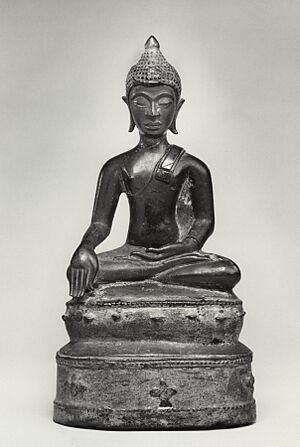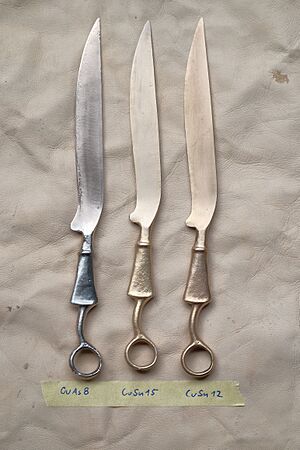Arsenical bronze facts for kids
Arsenical bronze is a special type of alloy made by mixing copper with arsenic. Sometimes, it also contains tin or other metals. When arsenic is added to copper, the final metal becomes much stronger and easier to shape when melted. This process is called casting.
Copper ore, which is rock containing copper, often naturally has some arsenic in it. So, when archaeologists talk about "arsenical bronze," they usually mean alloys with more than 1% arsenic. This helps them tell the difference between arsenic that was added on purpose and arsenic that was just there by accident.
Contents
How Arsenical Bronze Started
| Ore name | Chemical formula |
|---|---|
| Arsenopyrite | FeAsS |
| Enargite | Cu3AsS4 |
| Olivenite | Cu2(AsO4)OH |
| Tennantite | Cu12As4S13 |
| Malachite | Cu2(OH)2CO3 |
| Azurite | Cu3(OH)2(CO3)2 |
We find items made of arsenical bronze all over the world. The oldest ones, from about 7,000 years ago (the 5th millennium BC), were found in what is now Iran. Since arsenic is naturally found in many copper ores (like those in the table), some arsenic would always mix with the copper.
Scientists are still trying to figure out if ancient people added arsenic on purpose or if it just happened because of the type of copper ore they used. When people melted these ores to get metal, some arsenic would naturally end up in the bronze.
Making the Alloy
Ancient metalworkers might have made arsenical bronze in a few ways:
- They could have added metals or ores that contained arsenic, like realgar, directly to melted copper.
- They might have used special copper ores that already had arsenic and antimony, then processed them to get the alloy.
- Another way was to melt copper ores that contained sulfur and arsenic, like tennantite. However, this method would create harmful fumes.
- The most likely method was melting different types of ores together, such as malachite (a copper ore) and arsenopyrite (an arsenic ore). This method worked well and created fewer dangerous fumes.
Some experts also think that ancient people might have made iron arsenide on purpose during copper melting. This could then be traded and added to melted copper elsewhere to make arsenical bronze.
What Was It Used For?
People made all sorts of things from arsenical bronze, from axes to jewelry. To make these items, they would heat the metal in special pots called crucibles. Then, they would pour the melted metal into molds made of stone or clay.
After the metal cooled and became solid, they would polish it. For tools like axes, they would hammer the edges to make them stronger and sharper. This process is called work hardening. Finished objects could also be decorated with engravings.
Why Arsenical Bronze Was Great
Arsenic was likely mixed with copper because it was already in the ores. But people probably kept using it for good reasons:
- It made the metal better: Arsenic helped remove oxygen from the hot, melted metal. Too much oxygen in copper can make the final object weak and easy to break. Arsenic helped prevent this.
- It made tools stronger: Arsenical bronze could be made much harder than pure copper by hammering it. This made it much better for cutting or chopping tools. Even a small amount of arsenic (0.5% to 2%) could make the metal 10% to 30% harder and stronger.
- It looked good: With the right amount of arsenic, the metal could have a shiny, silvery look. There's evidence that ancient craftspeople in places like the Caucasus and Mexico deliberately made objects with an arsenic-rich surface to give them a silver color.
Where and When It Was Used
Many ancient societies and cultures around the world used arsenical bronze.
Early Use in the Middle East
The earliest use of arsenical bronze was in the Iranian plateau and nearby Mesopotamia (modern Iran, Iraq, and Syria). It was used there for almost 2,000 years, from the 4th millennium BC to the middle of the 2nd millennium BC. The amount of arsenic in artifacts varied a lot, so it's hard to know exactly how much was added on purpose.
Later research in 2016 helped clarify things. In eastern Turkey, at sites like Norşuntepe and Değirmentepe, arsenical bronze was being made before 4000 BC. They found furnaces, slag (waste from melting metal), and ores at these sites.
At Değirmentepe, arsenical copper objects were clearly made around 4200 BC. However, it seems the main melting of the ore happened somewhere else, perhaps near the mines. At Norşuntepe, there's better evidence that arsenic was added separately to the copper.
Societies like the Akkadians, the people of Ur, and the Amorites, who lived around the Tigris and Euphrates rivers, used arsenical bronze. These areas were important trade centers that helped spread arsenical bronze across the Middle East during the Bronze Age.
Other Regions
- Judean Desert: The Nahal Mishmar hoard in the Judean Desert contains many arsenical bronze objects (with 4–12% arsenic). These were made using the lost-wax process, which is a very complex technique. This shows advanced metalworking around 3500 BC.
- Ancient Egypt and Nubia: Arsenical bronze was used widely in ancient Egypt and Nubia from the second phase of the Naqada culture until the start of the New Kingdom. During the Old Kingdom, when the large pyramids were built, arsenical copper was used for tools at Giza.
- China: The use of arsenical bronze spread along trade routes into northwestern China, to the Gansu–Qinghai region. It's thought that these items were made locally, using local mineral resources.
- Northern Italy: In the Eneolithic period (around 2800 to 2200 BC), arsenical bronze was the most common alloy in the Mediterranean area, including Northern Italy.
- South America: Arsenical bronze was the main alloy in Ecuador and parts of Peru. This was because these areas had rich arsenic-containing ores. In contrast, other parts of South America, like Bolivia, had more tin ore, so they used tin bronze instead. The Sican Culture in Peru (900 to 1350 AD) was known for its use of arsenical bronze. It was valued because it could be easily hammered into thin sheets, which were important in their society.
Why Arsenical Bronze Was Replaced
In places like Egypt, Peru, and the Caucasus, arsenical bronze was used at the same time as tin bronze for a while. Even into the Iron Age, arsenical bronze was still used for small decorative items. This shows that newer alloys didn't always completely replace older ones right away.
From a metalworking point of view, tin bronze isn't much better than arsenical bronze. Some early writers thought arsenical bronze was stopped because of its health risks. However, it's more likely that tin bronze became more popular because it produced strong castings without needing as much extra hammering. Also, it was easier to control the exact amount of tin added to copper, making the results more predictable than with arsenic.
Health Effects of Using Arsenical Bronze
Arsenic creates fumes when heated. Ancient metalworkers who mined and processed ores with fire would have been exposed to these fumes. Long-term exposure to arsenic can affect the body, including causing weakness in the legs and feet.
Some people have suggested that this health effect might be why many old stories and myths, like the Greek god Hephaestus, feature smiths who are lame or have difficulty walking. While Hephaestus was an Iron Age smith, not a Bronze Age one, this idea might come from ancient memories of metalworkers' health issues.
A very well-preserved ancient person, known as Ötzi the Iceman, lived around 3,200 BC. Scientists found high levels of copper and arsenic in his hair. Since Ötzi also had a copper axe, scientists think he might have been involved in melting copper.
Arsenical Bronze Today
Arsenical bronze is not used much in modern times. The closest thing is called arsenical copper, which has less than 0.5% arsenic. Even a small amount of arsenic in copper can reduce how well it conducts electricity.
See also
- Arsenical copper
- Arsenical brass



